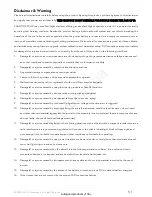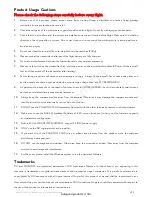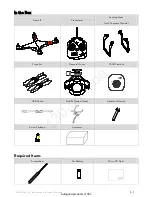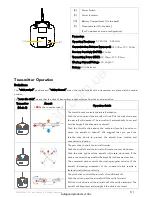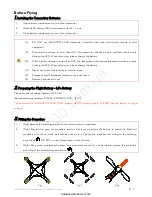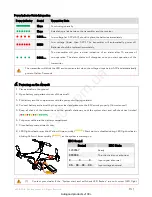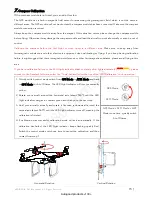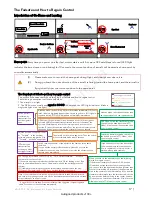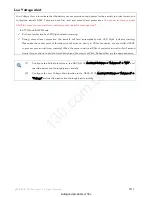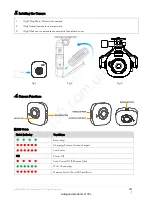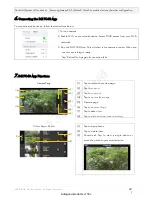
©2013-2014
DJI Innovations. All Rights Reserved.
8 |
[10]
[11]
[8]
[9]
[10]
[11]
Power Switch
Power Indicator
Battery Compartment (On the back)
Potentiometer (On the back)
(For Compliance version configuration)
Parameters
Operating Frequency
: 5.728 GHz
-
5.85 GHz
Communication Distance (open area):
CE 300m; FCC 500m
Receiver Sensitivity (1%PER):
-93dBm
Transmitting Power (EIRP):
CE 25mw; FCC 125mw
Working Current/Voltage
: 80 mA@6V
Battery:
4 AA Batteries
Transmitter Operation
Definitions
The ‘stick neutral’ positions and ‘stick released’ mean the control sticks of the transmitter are placed at the central
position.
To ‘move the stick’ means that the stick of transmitter is pushed away from the central position.
Transmitter
(Mode 2)
Aircraft
(
is the nose direction
)
Operation details
The throttle stick controls the aircraft elevation.
Push the stick up and the aircraft will rise. Pull the stick down and
the aircraft will descend. The aircraft will automatically hover and
hold its height if the sticks are centered.
Push the throttle stick above the centered (neutral) position to
cause the aircraft to take-off. We suggest that you push the
throttle stick slowly to prevent the aircraft from sudden and
unexpected elevation.
The yaw stick controls the aircraft rudder.
Push the stick left and the aircraft will rotate counter clock-wise.
Push the stick right and the aircraft will rotate clock-wise. If the
stick is centered, the aircraft will always fly in the same direction.
The command stick controls the rotating angular velocity of the
aircraft. Increasing movement of the command stick results in
faster aircraft rotation velocity.
The pitch stick controls the aircraft’s front & back tilt.
Push the stick up and the aircraft will tilt and fly forward.
Pull the stick down and the aircraft will tilt and fly backward. The
aircraft will keep level and straight if the stick is centered.
130.com.ua
Autogood products «130»




